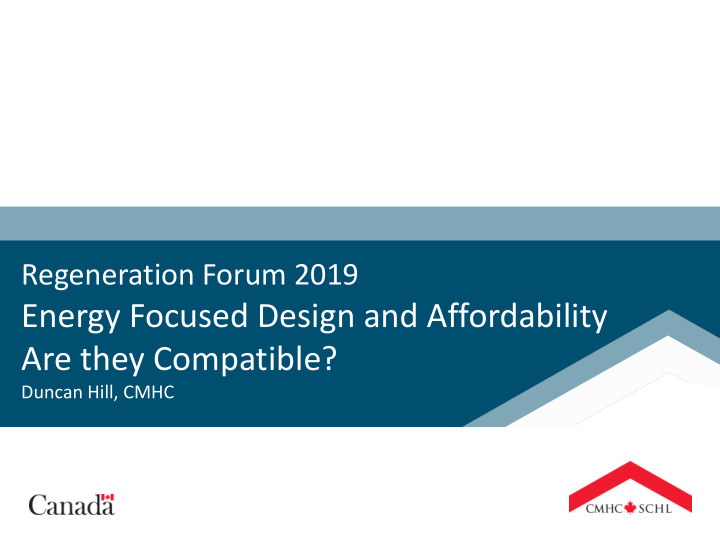



Regeneration Forum 2019 Energy Focused Design and Affordability Are they Compatible? Duncan Hill, CMHC CANADA MORTGAGE AND HOUSING CORPORATION
The Promise of Energy Efficiency and Conservation • Reduced energy consumption and peak energy demand • Reduced energy costs • Lower operating costs • Reallocation of savings to other purposes • Enhanced durability • Increased resiliency during power failures • Greater comfort and indoor air quality • Reduced GHG and other pollutant emissions • Occupant engagement/social inclusion • Better acoustic performance CANADA MORTGAGE AND HOUSING CORPORATION 2
Case Studies – A Very Current Classic Ottawa Co-op Completed 1996 4 Storeys, 84 apartments 97,959 ft 2 $5,950,000 or $60/ft2 or $70,833/apt Objectives: 1. To conserve resources and minimize waste 2. To build a vibrant, interactive and equitable community 3. To be affordable CANADA MORTGAGE AND HOUSING CORPORATION 3
Ottawa Co-op Energy Performance 2500000 2000000 ekWh/year 1500000 1000000 500000 0 Natural Gas Electricity Reference Code Building Conservation Co-op Measure kWh/year savings $/year savings Incremental Cost Simple Payback Low E Windows 151,502 $4,531 $39,988 8.8 Air Leakage Control 41,081 $1,229 $5,880 4.8 Wall Insulation 180,475 $5,398 $75,530 14 Heat Recovery Ventilation 225,921 $6,757 $67,912 10 Combo System 242,931 $7,266 $54,600 11.7 Total 841,910 $25,180 $245,247 9.7 CANADA MORTGAGE AND HOUSING CORPORATION 4
A West Coast Passive House 6 unit MURB Project • Annual energy consumption 72 kWh/m 2 ∙yr (33,570 kWh total); • 66% higher than predicted but well below typical code building at 132 kWh/m 2 /yr. • Construction (including soft) costs for the six unit Passive House MURB approximately $2,519/m 2 ($234/ft 2 ), or $1,134,000 total, • Incremental cost increase approximately 4.2%. ($47k) CANADA MORTGAGE AND HOUSING CORPORATION 5
Image vs Reality in Energy Efficient Housing Actual Energy (kWh/m 2 ∙yr) PHPP Modeled Energy kWh kWh/m 2 ∙yr kWh kWh/m 2 ∙yr Heating 4,130 8.8 4,690 10.0 Baseline 16,040 34.2 28,880 61.6 TOTAL 20,170 43 33,570 72 • Source of divergence is in base loads (plug loads, domestic hot water, etc). • Occupant preferences and behaviours have a significant impact on the final energy consumption. • Suite level utility data suggests a broad range in consumption between suites, further supporting this observation. CANADA MORTGAGE AND HOUSING CORPORATION 6
Economics of this Passive House Project Annual Energy Net Present Internal Rate Discounted Savings Value of Return (IRR) Payback Period (kWh/m 2 ) ($/m 2 ) (%) (Years) 60 -$13.93 5% 17 the upfront investment is marginally cost effective but • lower strata fees • increased resale value • Benefits will continue past 30 analysis period. CANADA MORTGAGE AND HOUSING CORPORATION 7
Housing Nova Scotia Passive House Projects CMHC working with Housing Nova Scotia to monitor the performance of 9 PH affordable housing projects Housing Nova Scotia reports early results as: • 40%-90% modelled energy reductions • Actual consumption within10 kWh/m 2 of • modelled values Incremental costs below 10% • Energy cost savings alone insufficient to support • going PH but there could be: decreased maintenance cost associated with • higher quality components. decreased o&m and repolacement costs • resulting from simpler space heating systems (credit: Housing Nova Scotia, Towards a Vision of Sustainable Affordability, CHRA Conference, May 2017) CANADA MORTGAGE AND HOUSING CORPORATION 8
Going for Net Zero in Affordable Family Housing North Glenora Family Housing Project- Edmonton – Right at Home Housing Society 16 units for large families Well-insulated envelope coupled with ground source heat pump system Air to water HPs in units 120 KW PV array CANADA MORTGAGE AND HOUSING CORPORATION 9
Going for Net Zero in Affordable Family Housing Modelled Performance: WITHOUT geothermal / WITH geothermal / solar solar Housing Total Annual Energy 164,996 109,960 Church Total Annual Energy 40,164 19,025 Total Site Annual Energy Demand 205,160 128,985 Predicted Production from PV 0 135,000 Annual Balance 205,160 6,015 CMHC is funding performance monitoring and cost-benefit analysis CANADA MORTGAGE AND HOUSING CORPORATION 10
Passive House for the Yale First Nation - BC The Project: • 6 plex Social Housing Project • 401m² (66.8m² per suite) • R-87 effective roof, R-64 effective floor and R-44 effective walls • Minimal thermal bridging • High performance PHI certified Euroline 4700 ThermoPlus series windows • Airtightness testing 0.44 ACH at 50Pa. • DHW is provided by a Heat Pump with a rated COP of 4.5 and backup electric water • Space heating and cooling system multi head ductless heat pump COP of 3.7 plus back up electric baseboard heaters • Annual site energy demand of 38.6 kWh/m²/yr CANADA MORTGAGE AND HOUSING CORPORATION 11
Passive House for the Yale First Nation - BC CMHC funding performance testing & monitoring for • Energy consumption • Indoor air quality • Thermal comfort • Thermal Bridging • Assess against targets and impact of occupants CANADA MORTGAGE AND HOUSING CORPORATION 12
Ottawa Salus Passive House Project • LEED Homes Multi-Family Platinum certification • Energy savings (51% reduction against OBC SB10 – 2012) • Primary energy 114 kWh/m 2 /a (PHPP) • Low water consumption confirmed (46% reduction against OBC 2012 – 77.2 L/pers/day) • Passive House certification (pending) • Some concern regarding summer overheating CANADA MORTGAGE AND HOUSING CORPORATION 13
Conclusions from Monitoring to Date • Affordability and energy efficiency are very compatible • Many non-profits, social housing projects leading way • Space heating energy consumption is fairly accurately estimated/predicted • Occupancy dependent energy consumption – not so much • Over-heating is a problem – when air conditioning not provided • AC omitted in belief that PH and natural ventilation sufficient • Incremental costs of low-energy design reported in 5%-10% range • Need for comprehensive assessments of capital costs, subsequent operating costs, o&m costs • Airtightness targets are being met for exterior envelope • Compartmentalization next? CANADA MORTGAGE AND HOUSING CORPORATION 14
Recommend
More recommend